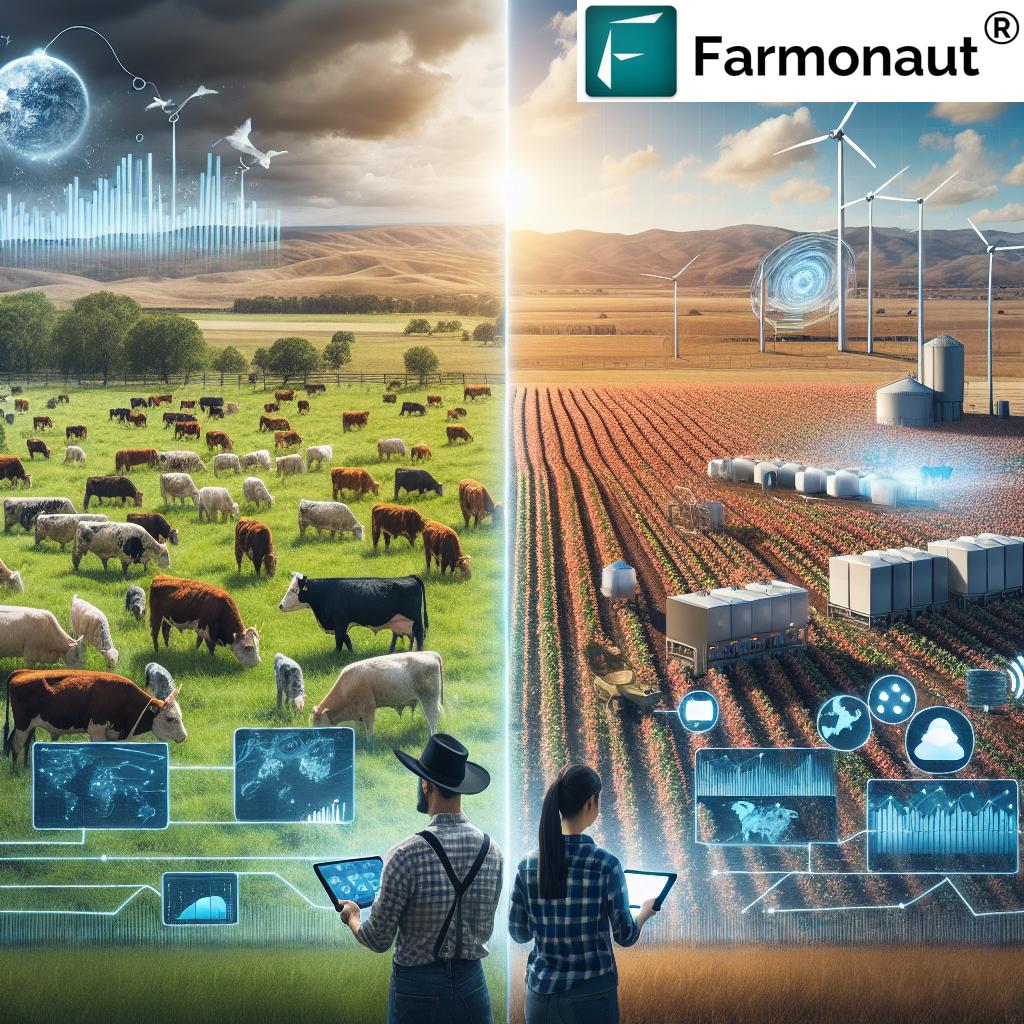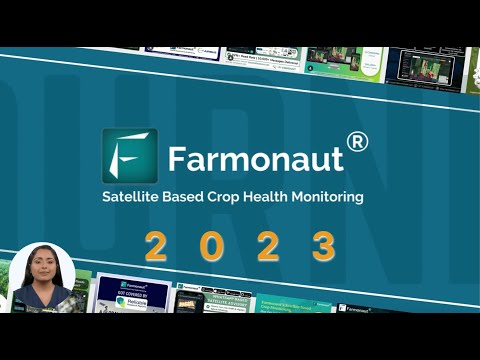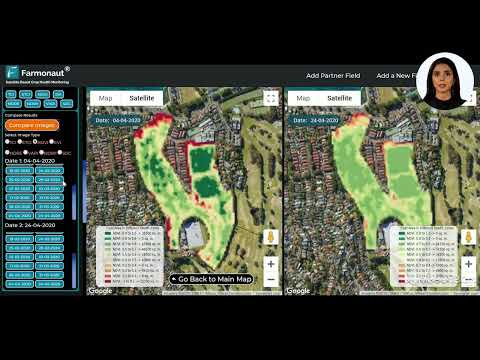Farmonaut’s Guide: Cross-Border Collaboration Shapes Future of North American Agriculture
“Agricultural associations from 3 North American countries are collaborating to address common industry challenges and sustainable farming practices.”
Welcome to Farmonaut’s comprehensive guide on the exciting developments shaping the future of North American agriculture! We’re thrilled to take you on a journey through the innovative world of cross-border collaboration, precision agriculture technology, and sustainable farming practices that are revolutionizing the industry across the United States, Canada, and Mexico.
As we delve into this fascinating topic, we’ll explore how agricultural associations from these nations are joining forces to tackle common challenges, with a particular focus on sustainable farming and cross-border agricultural collaboration. We’ll also highlight how Farmonaut’s advanced remote sensing solutions are helping farmers adapt to changing conditions, such as drought-resistant crop management and efficient livestock management systems.
So, grab your virtual passport, and let’s embark on this exciting agricultural journey across North America!
The Power of Cross-Border Agricultural Collaboration
In recent years, we’ve witnessed a remarkable shift in the agricultural landscape of North America. The United States, Canada, and Mexico have recognized the immense potential of working together to address shared challenges and opportunities in the farming sector. This collaborative spirit has given rise to numerous initiatives aimed at fostering sustainable farming practices, improving agricultural trade policies, and promoting technological innovation.
- Joint research projects on climate-resilient crops
- Shared databases for pest and disease management
- Harmonization of agricultural standards and regulations
- Cross-border knowledge exchange programs for farmers
These collaborative efforts are not just limited to government-level interactions. We’re seeing an increasing number of grassroots movements, where farmers from different countries are coming together to share experiences, best practices, and innovative solutions.

Precision Agriculture Technology: A Game-Changer for North American Farmers
At the heart of this agricultural revolution lies precision agriculture technology. This innovative approach is transforming farming practices across the continent, enabling farmers to make data-driven decisions and optimize their operations like never before.
Farmonaut is proud to be at the forefront of this technological revolution, offering cutting-edge remote sensing solutions that empower farmers to adapt to changing conditions and maximize their productivity. Our satellite-based crop health monitoring system provides real-time insights into vegetation health, soil moisture levels, and other critical metrics, helping farmers make informed decisions about irrigation, fertilizer usage, and pest management.
To experience the power of Farmonaut’s precision agriculture technology firsthand, check out our user-friendly platforms:
Sustainable Farming Practices: A Continental Priority
As we navigate the challenges of climate change and resource scarcity, sustainable farming practices have become a top priority for agricultural associations across North America. From the Midwest of the United States to the prairies of Canada and the diverse landscapes of Mexico, farmers are embracing innovative techniques to reduce their environmental impact while maintaining productivity.
- Conservation tillage and no-till farming
- Precision irrigation systems
- Integrated pest management
- Crop rotation and diversification
- Agroforestry and silvopasture
These practices not only help preserve soil health and biodiversity but also contribute to the overall resilience of North American agriculture in the face of changing climatic conditions.
Tackling Common Challenges: Agricultural Trade Policies
One of the key areas where cross-border collaboration is making a significant impact is in the realm of agricultural trade policies. The United States, Canada, and Mexico are working together to address common challenges and create a more unified approach to trade within the region.
Recent conferences and festivals have highlighted the power of united efforts in tackling issues like:
- Harmonization of food safety standards
- Reduction of non-tariff barriers to trade
- Development of common approaches to emerging technologies in agriculture
- Addressing labor shortages in the agricultural sector
These collaborative efforts are not only strengthening the economic ties between the three countries but also ensuring a more resilient and competitive North American agricultural sector on the global stage.
Drought-Resistant Crop Management: Adapting to Changing Climates
“Farmonaut’s remote sensing solutions assist farmers in managing drought-resistant crops and efficient livestock systems across multiple countries.”
As climate change continues to pose challenges for farmers across North America, the development and management of drought-resistant crops have become increasingly important. Farmonaut’s advanced remote sensing solutions are playing a crucial role in helping farmers adapt to these changing conditions.
Our satellite-based monitoring system allows farmers to:
- Track soil moisture levels in real-time
- Identify areas of water stress in crops
- Optimize irrigation scheduling
- Monitor the performance of drought-resistant varieties
By leveraging this technology, farmers can make informed decisions about water management, crop selection, and planting schedules, ultimately improving their resilience to drought conditions.

Efficient Livestock Management Systems: Revolutionizing Animal Agriculture
The cattle and livestock industry is a crucial component of North American agriculture, and it’s undergoing a significant transformation thanks to cross-border collaboration and technological advancements. Farmonaut’s remote sensing solutions are helping ranchers and livestock producers across the continent implement more efficient management systems.
Our technology enables:
- Pasture health monitoring for optimal grazing management
- Early detection of potential disease outbreaks
- Tracking of animal movement and behavior patterns
- Optimization of feed and water resources
By adopting these advanced systems, ranchers in the United States, Canada, and Mexico are improving animal welfare, reducing environmental impact, and increasing the overall efficiency of their operations.
The Evolving Rural Real Estate Market
As the agricultural landscape continues to evolve, we’re witnessing significant changes in the rural real estate market across North America. There’s an increasing emphasis on tech-savvy farms equipped for modern agriculture, reflecting the growing importance of precision farming and sustainable practices.
Key trends in the rural real estate market include:
- Higher premiums for farms with advanced technological infrastructure
- Growing interest in properties suitable for sustainable and organic farming
- Increased demand for land with reliable water sources
- Rise of multi-functional agricultural properties (e.g., agritourism)
These trends highlight the changing face of agriculture and the increasing value placed on farms that are well-positioned to thrive in the digital age.
Emerging Frontiers: Cell-Cultured Food Production
As we look to the future of North American agriculture, one of the most exciting and potentially disruptive developments is the emergence of the cell-cultured food industry. This innovative approach to food production is gaining traction across the continent, with researchers and entrepreneurs in the United States, Canada, and Mexico exploring its potential.
Key aspects of cell-cultured food production include:
- Development of lab-grown meat and dairy alternatives
- Potential reduction in environmental impact compared to traditional livestock farming
- Challenges in scaling up production and achieving cost-effectiveness
- Regulatory considerations and consumer acceptance
While still in its early stages, the cell-cultured food industry represents a fascinating frontier in agricultural innovation, with potential implications for food security, sustainability, and animal welfare.
Comparative Analysis of Agricultural Collaboration Initiatives
To provide a comprehensive overview of the cross-border agricultural collaboration initiatives between the United States, Canada, and Mexico, we’ve compiled the following comparative analysis:
| Initiative Feature | United States | Canada | Mexico |
|---|---|---|---|
| Primary Focus Areas | Sustainable farming, trade policies | Climate-resilient agriculture, technology adoption | Water management, small-holder support |
| Technological Adoption Rate | 75% | 70% | 60% |
| Key Conferences/Events | North American Agricultural Forum (June 2023) | Canadian-US Crop Innovation Summit (September 2023) | Tri-National Agtech Expo (November 2023) |
| Notable Joint Research Projects | Drought-resistant corn varieties | AI-driven pest management systems | Sustainable water use in arid regions |
| Challenges Addressed | Drought management, trade barriers | Climate change adaptation, labor shortages | Water scarcity, market access for small farmers |
| Investment in Precision Agriculture | $15 billion annually | $5 billion annually | $2 billion annually |
| Rural Real Estate Trends | High demand for tech-equipped farms | Growing interest in sustainable properties | Increasing value of water-rich lands |
| Government Support Programs | Farm Bill, USDA grants | Canadian Agricultural Partnership | PROCAMPO, technological modernization funds |
| Emerging Technologies | Cell-cultured meat, vertical farming | Precision fermentation, robotics in agriculture | Smart irrigation systems, solar-powered farms |
| Future Collaboration Goals | Harmonized food safety standards | Joint climate change mitigation strategies | Integrated North American agri-food supply chain |
This comparative analysis highlights the diverse yet interconnected nature of agricultural initiatives across North America, showcasing the power of cross-border collaboration in driving innovation and sustainability in the sector.
The Role of Agricultural Associations in Fostering Collaboration
Agricultural associations play a crucial role in facilitating cross-border collaboration and driving innovation in the industry. These organizations serve as vital links between farmers, researchers, policymakers, and industry stakeholders, helping to coordinate efforts and share knowledge across national boundaries.
Key functions of agricultural associations in fostering collaboration include:
- Organizing international conferences and trade shows
- Facilitating farmer exchange programs
- Lobbying for harmonized regulations and standards
- Coordinating joint research initiatives
- Disseminating information on best practices and emerging technologies
By bringing together diverse perspectives and expertise from across North America, these associations are helping to create a more resilient and innovative agricultural sector that can better respond to global challenges.
The Future of North American Agriculture: Embracing Innovation and Collaboration
As we look to the future, it’s clear that the success of North American agriculture will depend on our ability to embrace innovation, foster collaboration, and adapt to changing environmental and economic conditions. By working together across borders, leveraging advanced technologies like those offered by Farmonaut, and prioritizing sustainability, we can create a more resilient and prosperous agricultural sector for generations to come.
Key areas to watch in the coming years include:
- Continued advancements in precision agriculture and remote sensing technology
- Further integration of artificial intelligence and machine learning in farming practices
- Development of new drought-resistant and climate-adaptive crop varieties
- Expansion of regenerative agriculture practices
- Growth of the cell-cultured food industry and other alternative protein sources
By staying informed about these developments and actively participating in cross-border initiatives, farmers, ranchers, and agricultural stakeholders across North America can position themselves for success in an ever-changing industry.
Farmonaut: Your Partner in Agricultural Innovation
At Farmonaut, we’re committed to supporting the future of North American agriculture through our advanced remote sensing solutions and data-driven insights. Our platform empowers farmers across the continent to make informed decisions, optimize their operations, and adapt to changing conditions.
To learn more about how Farmonaut can help you stay at the forefront of agricultural innovation, explore our range of services:
Farmonaut API – Integrate our powerful satellite and weather data into your own systems.
API Developer Docs – Access comprehensive documentation for seamless integration.
Join us in shaping the future of North American agriculture through innovation, collaboration, and sustainable practices!
Farmonaut Subscriptions
Frequently Asked Questions
Q: How is cross-border collaboration benefiting North American agriculture?
A: Cross-border collaboration is fostering innovation, addressing common challenges like climate change and trade policies, and promoting the sharing of best practices and technologies across the United States, Canada, and Mexico.
Q: What role does precision agriculture technology play in modern farming?
A: Precision agriculture technology, such as Farmonaut’s remote sensing solutions, enables farmers to make data-driven decisions, optimize resource use, and improve crop yields while reducing environmental impact.
Q: How are sustainable farming practices being implemented across North America?
A: Farmers are adopting techniques like conservation tillage, precision irrigation, integrated pest management, and crop diversification to enhance sustainability and resilience in their operations.
Q: What are some emerging trends in the rural real estate market?
A: There’s growing demand for tech-equipped farms, properties suitable for sustainable and organic farming, and land with reliable water sources. Multi-functional agricultural properties are also gaining popularity.
Q: How is the cell-cultured food industry impacting traditional agriculture?
A: While still in its early stages, the cell-cultured food industry is exploring alternatives to traditional livestock farming, potentially offering more sustainable protein sources with reduced environmental impact.
As we conclude our journey through the exciting world of North American agricultural collaboration, we hope you’ve gained valuable insights into the innovative practices, technologies, and partnerships shaping the future of farming across the continent. Remember, at Farmonaut, we’re here to support you every step of the way as you navigate this evolving landscape. Together, we can cultivate a more sustainable, efficient, and prosperous agricultural sector for generations to come.






